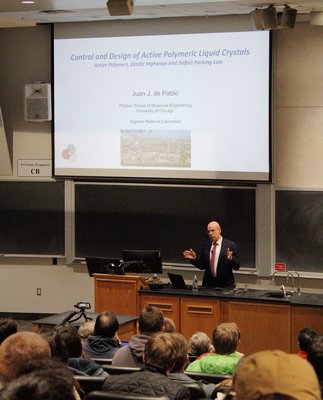Izatt-Christensen Lecture 2023 Review
March 29, 2023
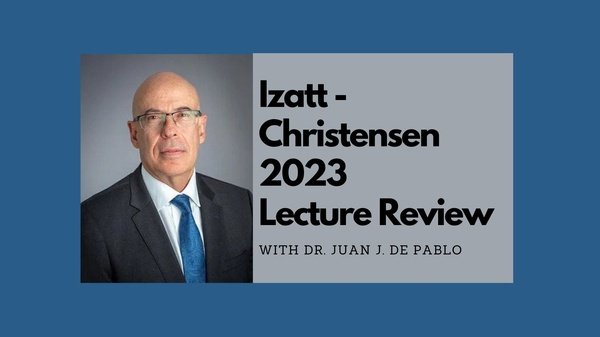
On February 16, 2023, students from various mathematical and scientific disciplines gathered in classrooms on Brigham Young University’s campus to learn from Dr. Juan J. de Pablo, Liew Family professor for the Pritzker School of Molecular Engineering at the University of Chicago and this year’s Izatt-Christensen Award recipient and lecturer. De Pablo instructed two seminar sessions intended for technical use by students and, later, for public interest and explanation, highlighting two of his most recent projects in studying protein turbulence and plastic production improvements.
Technical Morning Lecture
For the past five years, de Pablo and his team have been studying the nematic behavior patterns in LC systems. The subject of his morning technical lecture, de Pablo described to students how his group observed defective motion behaviors in polymers and their potential use in transporting materials in liquid crystals. In their research to understand how these irregularly-patterned polymers behave, they noted what they term a “Saturn-ring defect,” in which surrounding crystals become perpendicular to an external structure. Using synchrotron x-rays to measure electron density and experimenting with the presence of natural light-derived polymers, his team has learned how to use light to instigate or halt the development of defects.
To better understand how these polymers migrate, de Pablo and his team applied the study of the three principles of Continuum Theory: entropy, system elasticity, and surface contribution. Using equations for momentum, structure coupling, and the Lattice Boltzmann approach, they’ve been able to create experiments designed to replicate the results of a controlled environment; this research has resulted in processes using “active nematics confined in a shell” that lead to “topological defects,” employing the Validation Theoretical Framework, and ellipsoidal smectic shells. Exploiting the instability, migration patterns, and determining constants has proved challenging to de Pablo and his team because of the polarity habits and large filaments of their material. They ultimately chose to substitute their previous materials with actin, with filaments of only 2 μM. As such, and tracking angle size to determine consistencies, his team has learned that the properties and evolution patterns of the polymer defects varies based on subject material.
As a result of their research de Pablo’s lab has determined that higher, more frequent levels of activity equate to a higher number of defects. The most powerful flow is achieved when energy is high, they have noticed equilibrium patterns in distance between defective pairs, and have identified optimal defects as the most mobile and fast. Their research is continually unveiling new information about the relationships between proteins, electrons, and semiconductors and has made apparent the need for gate and amplifier creation to harness the full potential of these molecules.
With many implications, one of the most notable is the ability of these systems to mix and analyze DNA composition.
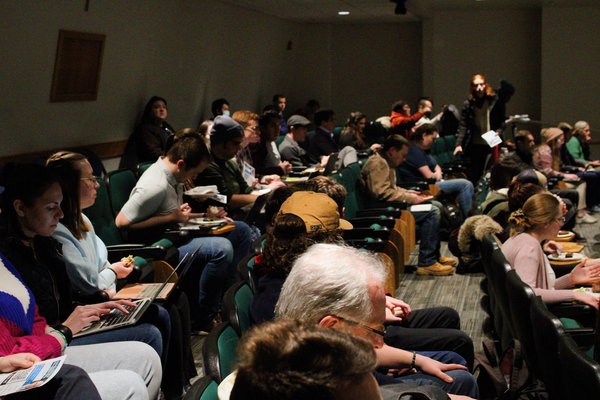
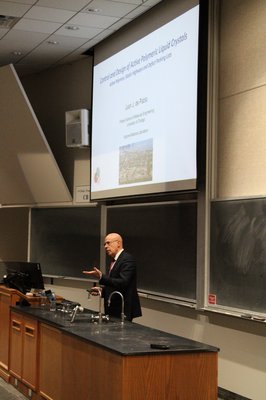
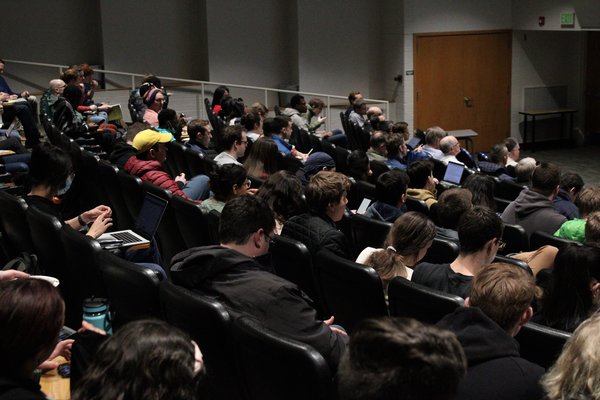
Public Evening Lecture
For his evening lecture, de Pablo focused on the environmental implication of high levels of plastic consumption and the efforts being made by his lab and research to provide practical, ecological solutions. De Pablo opened his lecture by stating that “the weight of plastics in the ocean will exceed that of fish by 2050.” Aside from posing strangulation risks for aquatic flora and fauna, de Pablo explained that the plastics previously and currently manufactured contain a high concentration of carcinogens - both in the plastic itself and as byproduct waste. High levels of toxicity offer grim prospects for the future of ecological systems that are essential in maintaining quality life for plants, land and marine animals, and human beings.
The invention and production of plastic, however, has provided extraordinary opportunities. De Pablo described that plastics have made innovation and safety possible in healthcare development and have provided a more sustainable and fuel efficient alternative to other material production. The question de Pablo poses is this: “How can we improve plastics to continue to be useful but also recyclable and sustainable for the environment?”
Ultimately, the challenge lies in creating biodegradable plastic autoencoders. Through a series of samples, tests, observation of molecular density, and data collection, de Pablo and his team have been able to create graphs and utilize - while simultaneously contributing to - databases that can “predict multiple chemical properties at once.” Comparing the data from these models and looking at the projected degradation trends is allowing chemists like de Pablo to start the process of making new compounds that fulfill the multi-faceted needs of plastic production while having a healthier environmental impact. They are accomplishing this by using the Entangled PS Melt method and tracking material viscosity over time to rapidly extract the best molecules for their project.
De Pablo and his team are working in collaboration with Apple and other influential companies to substitute the molecules for plastic production with their new and improved replacements. These new polymers have the potential to not only be environmentally friendly and biodegradable, but stronger and more durable as well. Despite setbacks, his team is optimistically working on finding feasible ways to phase in this new era of plastic production while discovering methods for breaking down old plastic products.
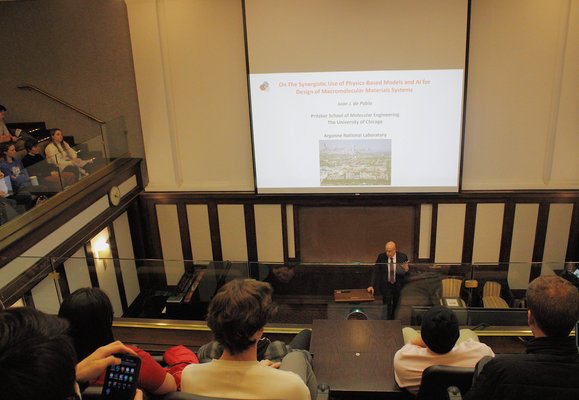
About Dr. Juan J. de Pablo
Dr. Juan J. de Pablo is a professor at the University of Chicago’s school of engineering and is a member of the Argonne National Laboratory. He is also the Executive Vice President for Science, Innovation, National Laboratories, and Global Initiatives. A distinguished chemist and recipient of multiple awards, more about his professional life and research lab can be found at https://pme.uchicago.edu/faculty/juan-de-pablo.
